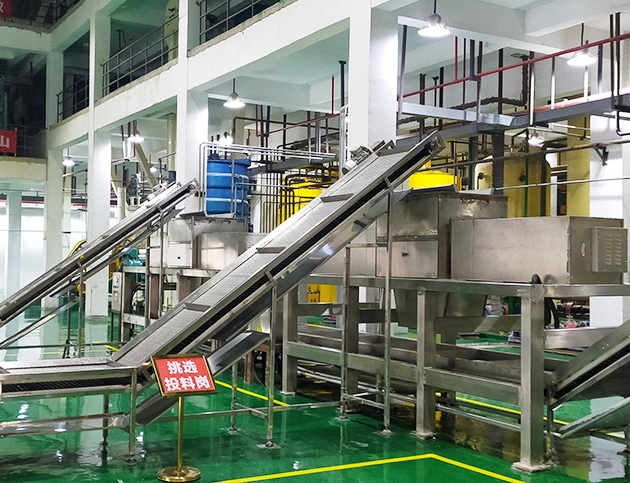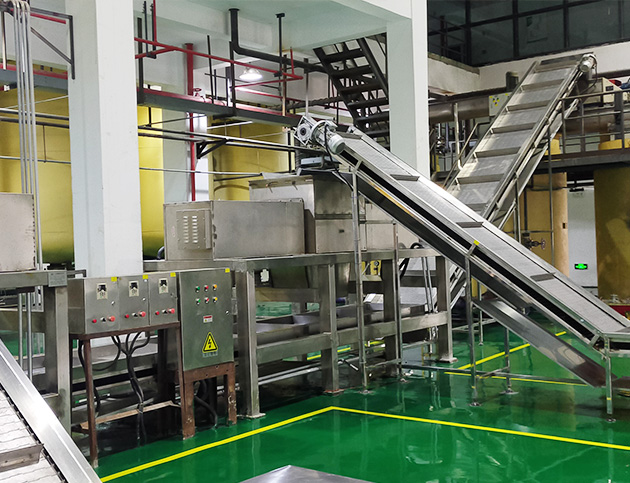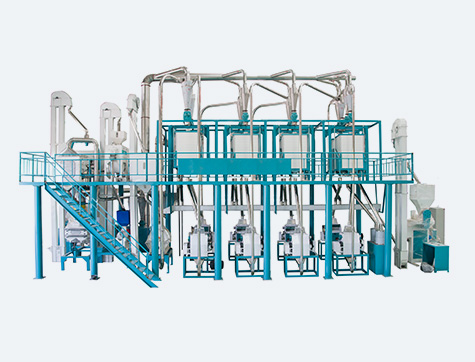





Palm oil production line
Palm fruit→Killing fermentation→abscission→mashing→press→crush palm oil
Crush palm oil→filtration→precipitates→drying→refining(degumming→deacidzing→decolorizing→deodorizing)→fractionation→palm fiber / palm stearin→storage and packaging
Description
Process flow
Palm fruit→Killing fermentation→abscission→mashing→press→crush palm oil
crush palm oil→filtration→precipitates→drying→refining(degumming→deacidzing→decolorizing→deodorizing)→fractionation→palm fiber / palm stearin→storage and packaging
Operation step
1. Receipt and storage of raw materials
1.1 Installation of an automatic weighing system on the unloading platform to accurately measure the amount of palm fruits received in each batch to facilitate cost accounting and inventory management.
1.2 Receiving hopper adopts anti-clogging design, such as installing vibrator or tilting angle optimization, to ensure smooth flow of palm fruits into the subsequent equipment.
1.3 The temporary storage warehouses are equipped with temperature and humidity monitoring devices to monitor environmental conditions in real time, so as to prevent palm fruits from deteriorating due to excessive humidity or uncomfortable temperatures. At the same time, ventilation and dehumidification equipment can be installed to keep the air in the warehouse dry.
2. Killing fermentation
2.1 Adopt advanced steam control system to precisely regulate the steam pressure and temperature in the leavening tank to ensure stable leavening effect. Pressure and temperature sensors can be installed and connected with the control system to realize automatic control.
2.2 Optimize the structural design of the fermentation tank to improve the uniformity of steam distribution so that the palm fruits can be fully subjected to heat and fermentation. For example, steam distribution pipes or nozzles are installed inside the tank to ensure that the steam can uniformly contact each palm fruit.
2.3 Increase the monitoring equipment of killing fermentation time and temperature, real-time feedback parameters of the killing fermentation process, in order to adjust the process conditions in time. At the same time, the database can be established and the fermentation parameters can be continuously optimized through data analysis.
3. Abscission
3.1 Choose high-efficiency fruit removal machines to improve fruit removal efficiency and fruit recovery rate. Consideration can be given to the use of new types of fruit removal technology, such as ultrasonic fruit removal or high-pressure water jet fruit removal, to reduce the damage to the fruit.
3.2 Fruit sorting equipment is installed at the exit of the fruit remover to separate the unshed bunches and broken fruits for secondary fruit removal or other processing to improve the utilization rate of raw materials.
3.3 Optimize the conveying system for fruit bunches and palm fruits to reduce fruit loss and equipment blockage during conveying. Closed conveying equipment can be used or sweeping devices can be added to ensure that the conveying channel is smooth.
4. Mashing
4.1 Adopt intelligent mashing machine to automatically adjust the mashing strength and time according to the characteristics of palm fruits and production requirements. Sensors can be installed to monitor the degree of fruit crushing, real-time feedback to the control system to realize automatic control.
4.2 Screen the mashed puree to remove oversized particles and impurities and to improve the efficiency of subsequent pressing. Screening can be carried out using equipment such as vibrating screens or cyclones.
4.3 Optimize the maintenance and repair process of the masher, regularly check the wear and tear of the knives and equipment, and replace damaged parts in time to ensure the stable operation of the equipment.
5. Press
5.1 Choose advanced pressing equipment, such as double screw press or hydraulic press combined with screw press, to improve oil yield and production efficiency. Suitable pressing equipment can be selected according to different production scale and raw material characteristics.
5.2 Optimize the pressing process parameters, such as adjusting the pressing pressure, temperature and time, to improve the extraction rate of oil. The optimal pressing process parameters can be determined by experiment and data analysis.
5.3 Add appropriate amount of auxiliaries, such as enzyme preparation or surfactant, to improve the oil fluidity and pressing efficiency in the pressing process. At the same time, pay attention to the safety and environmental protection of the additives.
6. Crude oil treatment
6.1 Use a multi-stage filtration system to improve the filtration effect of the gross oil. A coarse filter can be used first to remove larger impurities, followed by a fine filter to remove tiny particles and suspended matter.
6.2 Optimize the design of the sedimentation tank, increase the mixing device or adopt the inclined plate sedimentation technology to improve the sedimentation efficiency and speed. At the same time, an automatic slag removal system can be installed to regularly clean the impurities in the sedimentation tank.
6.3 Adopt advanced vacuum drying technology, such as microwave vacuum drying or freezing vacuum drying, to improve drying efficiency and oil quality. At the same time, pay attention to the control of drying temperature and time to avoid oxidation and deterioration of oil.
7. Refining
7.1 Adopt continuous refining process to improve refining efficiency and product quality stability. The processes of degumming, deacidification, decoloration and deodorization can be integrated in a continuous production line, realizing automatic control and efficient production.
7.2 Optimize the refining process parameters, such as alkali dosage, temperature and time, to improve the deacidification effect and the recovery rate of oil. The optimal refining process parameters can be determined by experiment and data analysis.
7.3 Choose efficient adsorbent and decolorant to improve the decolorization effect and the appearance quality of oil products. At the same time, pay attention to the regeneration and recycling of adsorbent and decolorant to reduce the production cost.
8. Fractionation
8.1 Adopt advanced fractionation technology, such as dry fractionation or solvent fractionation, to improve fractionation efficiency and product quality. Suitable fractionation technology can be selected according to different product requirements.
8.2 Optimize the fractionation process parameters, such as cooling rate, crystallization temperature and time, to improve the fractionation effect and product purity. The optimal fractionation process parameters can be determined by experiment and data analysis.
8.3 Fine filtration of the product after fractionation to remove residual impurities and crystals and to improve the appearance quality and stability of the product. Microporous filters or ultrafiltration equipment can be used for filtration.
9. Storage and packaging of finished products
9.1 Choose high-quality finished product storage tanks to ensure the storage safety and stable quality of oil products. Stainless steel tanks or tanks lined with anti-corrosive materials can be used to prevent the oil from being contaminated and corroded.
9.2 Optimize packaging equipment and processes to improve packaging efficiency and product appearance quality. Automated packaging equipment, such as filling machines, sealing machines and labeling machines, can be used to achieve efficient production.
9.3 Establish a strict quality inspection system for finished products and test each batch of products to ensure that the products meet national standards and customer requirements. At the same time, the quality control of packaging materials can be strengthened to ensure the safety and environmental protection of packaging materials.
10. Auxiliary
10.1 Optimize the wastewater treatment process and adopt advanced biological treatment technology or membrane separation technology to improve the effect of wastewater treatment and the recycling rate of water resources. At the same time, pay attention to the sludge treatment and discharge problems in the wastewater treatment process.
10.2 Effective treatment of waste gas, using adsorption, combustion or catalytic oxidation and other technologies to remove odors and harmful substances in the waste gas. At the same time, attention should be paid to the operating efficiency and maintenance cost of the exhaust gas treatment equipment.
10.3 Strengthen the comprehensive utilization of waste residues, and process waste residues such as palm fruit meal and soap feet into products such as feed, fertilizer or biomass fuel, so as to improve the utilization rate of resources and economic benefits.
Through the above measures, the production efficiency, product quality and resource utilization rate of palm oil production line can be improved, the production cost and environmental pollution can be reduced, and sustainable development can be realized.
Technical Parameters
Application Field
Related Products
Inquiry
Please Feel to give your inquiry in the form.We will reply you in 24 hours.





